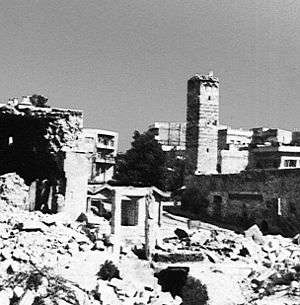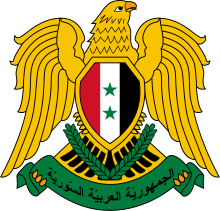Islamist uprising in Syria
| Islamist uprising in Syria | |||||||
|---|---|---|---|---|---|---|---|
 A section of Hama, after the 1982 Hama Islamic uprising | |||||||
| |||||||
| Belligerents | |||||||
|
| ||||||
| Commanders and leaders | |||||||
|
| ||||||
| Strength | |||||||
|
Several hundred "hard-core" Islamists Thousands loosely armed supporters and sympathizers | 80,000 | ||||||
| Casualties and losses | |||||||
| 10,000+ | 1,000 Soldiers | ||||||
| Total death toll unknown estimates vary to 5,000 – 40,000 killed[3] | |||||||
The Islamist uprising in Syria were a series of revolts and armed insurgency by Sunni Islamists, mainly members of the Muslim Brotherhood from 1976 until 1982. The uprising was aimed against the authority of the secular Ba'ath Party-controlled government of Syria, in what has been called a "long campaign of terror".[4] During the violent events Islamists attacked both civilians and off-duty military personnel, and civilians were also killed in retaliatory strike by security forces. The uprising had reached its climax in the 1982 Hama Islamic uprising.[5]
Background
 |
| This article is part of a series on the politics and government of Syria |
|
Legislature |
|
The first clash between the secular Ba'ath party and the Islamist Brotherhood in Syria occurred shortly after the 1963 Ba'athist coup, in which the Ba'ath party gained power in Syria. From the start, Islamist political groups, of which the Brotherhood was the most prominent, represented the strongest opposition to the new government. The outlawing of the Brotherhood in 1964 resulted in its radicalization. In 1964 and 1965, strikes and mass demonstrations spread throughout Syria's major cities, especially in Hama, and were crushed by the military. The town of Hama in particular was a "stronghold of landed conservatism and of the Muslim Brothers," and "had long been a redoubtable opponent of the Ba'athist state."[6]
On 31 January 1973, Assad implemented the new Constitution which led to a national crisis. Unlike previous constitutions, this one did not require that the president of Syria must be a Muslim, leading to fierce demonstrations in Hama, Homs and Aleppo organized by the Muslim Brotherhood and the ulama. They labeled Assad as the "enemy of Allah" and called for a jihad against his rule.[7] Robert D. Kaplan has compared Assad's coming to power to "an untouchable becoming maharajah in India or a Jew becoming tsar in Russia—an unprecedented development shocking to the Sunni majority population which had monopolized power for so many centuries."[8]
History
Sporadic insurgency 1976–1979
Following the Syrian occupation of Lebanon in 1976, a number of prominent Syrian officers and government servants, as well as "professional men, doctors, teachers," were assassinated. Most of the victims were Alawis, "which suggested that the assassins had targeted the community" but "no one could be sure who was behind" the killings.[9] The Muslim Brotherhood which had disdain for the Alawites and considered them non-Muslims was most likely responsible for the terror.
It was speculated that the government of Saddam Hussein in Iraq provided logistical and military support to the Brotherhood.[10]
Local revolts: November 1979 – January 1982
In November 1979, a Brotherhood leaflet stated:
We reject all forms of despotism, out of respect for the very principles of Islam, and we don't demand the fall of Pharaoh so that another one can take his place. Religion is not imposed by force....[11]
Widescale assassinations led up to 16 June 1979 slaughter of cadets at the Aleppo Artillery School. On that day a member of school staff, Captain Ibrahim Yusuf, assembled the cadets in the dining-hall and then let in the gunmen who opened fire on the cadets. According to the official report 32 young men were killed. Unofficial sources say the "death toll was as high as 83."[12] This attack was the work of Tali'a muqatila, or Fighting Vanguard, a Sunni Islamist guerrilla group and spinoff of the Muslim Brotherhood. `Adnan `Uqla, who later became the group's leader, helped plan the massacre.[13]
The cadet massacre "marked the start of full-scale urban warfare" against Alawis, cadre of the ruling Ba'ath party, party offices, "police posts, military vehicles, barracks, factories and any other target the guerrillas could attack." In the city of Aleppo between 1979 and 1981 terrorists killed over 300 people, mainly Ba'thists and Alawis, but also a dozen Islamic clergy who had denounced the murders. Of these the most prominent was Shaykh Muhammad al-Shami, who was slain in his own mosque, the Sulaymaniya, on 2 February 1980.
In the days leading up to 8 March 1980 (the seventeenth anniversary of the Ba'thist coup), nearly all Syrian cities were paralysed by strikes and protests, which developed into pitched battles with security forces. Many organizations, both religious and secular, were involved, including the most notable Muslim Brotherhood. The events escalated into a widescale crackdown in Aleppo, where the government responded with overwhelming military force, sending in tens of thousands of troops, supported by tanks and helicopters. In and around Aleppo, hundreds of demonstrators were killed, and eight thousand were arrested. By April, the uprising in the area had been crushed.[14]
On 26 June 1980 the Syrian dictator, Hafez al-Assad, "narrowly escaped death", when attackers threw two grenades and fired machine gun bursts at him as he waited at a diplomatic function in Damascus.[15] The attack prompted a series of deadly retaliations by the government troops.
On 27 June 1980 an estimated 1,152 Islamist inmates at the prison in Palmyra were massacred by the alawi-ruled government Defense companies troops. Less than a month later, membership in the Muslim Brotherhood became punishable by death with a month grace period given for members to turn themselves in.
In August 1980, after an attack on soldiers stationed in Aleppo, the army executed nearly 80 residents of a block of flats that happened to be located nearby.
In April 1981, after a failed terrorist attack on an Alawite village near Hama, the army executed about 400 of Hama's inhabitants, chosen randomly among the male population over the age of 14.[16]
Later in 1981, during a 50-day moratorium on the application of 7 July law, over a thousand Muslim Brothers turned themselves in, hoping to escape the death penalty; information published about them in the official press may give some insight into the composition of the Brotherhood's membership at that time. Most of those, who gave themselves in, were students under 25 years of age, from Damascus and other large cities; others were schoolteachers, professors or engineers.[16]
In August, September and November 1981, the Brotherhood carried out three car-bomb attacks against government and military targets in Damascus, killing hundreds of people, according to the official press.[17]
Hama Islamic uprising – February 1982
The insurgency is generally considered to have been crushed by the bloody Hama massacre of 1982, in which thousands of insurgents, soldiers and residents were killed, according to anti Syrian Government claims "the vast majority innocent civilians".[18][19] On 2 February 1982, the Brotherhood led a major insurrection in Hama, rapidly taking control of the city; the military responded by bombing Hama (whose population was about 250,000) throughout the rest of the month, killing between 1,000 and 25,000 people. The Hama events marked the defeat of the Brotherhood, and the militant Islamic movement in general, as a political force in Syria.[20][21]
Aftermath
Having suppressed all opposition, Hafez al-Assad released some imprisoned members of the Brotherhood in the mid-1990s. After his death in 2000, Assad was succeeded by his son, Bashar al-Assad, who initially signalled greater openness to political debate. In May 2001, encouraged by this new political climate, the Muslim Brotherhood published a statement in London rejecting political violence, and calling for a modern, democratic state. Many political prisoners, including Muslim Brothers, were pardoned and released. However, this "Damascus spring" was short-lived; in the same year, the few political freedoms that had been granted were abruptly revoked.[22]
Although its leadership is in exile, the Brotherhood continues to enjoy considerable sympathy among Syrians. Riyad al-Turk, a secular opposition leader, considers it "the most credible" Syrian opposition group. The Brotherhood has continued to advocate a democratic political system; it has abandoned its calls for violent resistance and for the application of shari'a law, as well as for Sunni uprisings against Alawites. Al-Turk and others in the secular opposition are inclined to take this evolution seriously, as a sign of the Brotherhood's greater political maturity, and believe that the Brotherhood would now be willing to participate in a democratic system of government.[23]
In a January 2006 interview, the Brotherhood's leader, Ali Sadreddine Bayanouni, "said the Muslim Brotherhood wants a peaceful change of government in Damascus and the establishment of a 'civil, democratic state', not an Islamic republic."[24] According to Bayanouni, the Syrian government admits having detained 30,000 people, giving a fair representation of the Brotherhood's strength.[18]
List of assassinations during the uprising
Individuals assassinated between 1976–1979
- the commander of the Hama garrison, Colonel Ali Haydar, killed in October 1976
- the rector of Damascus University, Dr. Muhammad al-Fadl, killed in February 1977
- the commander of the missile corps, Brigadier 'Abd al Hamid Ruzzug, killed in June 1977
- the doyen of Syrian dentists, Dr Ibrahim Na'ama, killed in March 1978
- the director of police affairs at the Ministry of the Interior, Colonel Ahmad Khalil, killed in August 1978
- Public Prosecutor 'Adil Mini of the Supreme State Security Court, killed in April 1979.
- President Hafez Asad's own doctor, the neurologist Dr. Muhammad Shahada Khalil, who was killed in August 1979.[25]
Individuals assassinated between 1980–1982
- Salim al-Lawzi, publisher of al-Hawadith, in Lebanon killed by Syrian assassins in March 1980.
- Riad Taha, head of the journalists' union in Beirut killed in July 1980.
- Banan al-Tantawi, wife of the former general director of Muslim Brothers Issam al-Attar, killed in Aachen in July 1980.
- Salah al-Din Bitar, co-founder of the Ba'ath Party killed in Paris on 21 July 1980.
While the involvement of the Syrian government "was not proved" in these killings, it "was widely suspected."[26]
| Wikimedia Commons has media related to Islamist uprising in Syria. |
See also
- Human rights in Syria
- List of modern conflicts in the Middle East
- Syrian Civil War
- Terrorism in Syria
References
- ↑ "Timeline: The Syrian revolt". Al Jazeera.
- 1 2 3 4 5 "History Repeats Itself as Tragedy". Foreign Policy. 21 September 2012. Retrieved 22 September 2012.
- ↑ "Hamah (Hama), Syria, 1982". Global Security.
- ↑ Seale, Patrick, Asad, the Struggle for the Middle East, University of California Press, 1989, p.336-7
- ↑ "Sufism and Sufi Brotherhoods in Syria and Palestine". ou.edu.
- ↑ Seale 1989: 93
- ↑ Alianak 2007, p. 55.
- ↑ Kaplan, Robert (February 1993). "Syria: Identity Crisis". The Atlantic.
- ↑ Seale, p.316-7
- ↑ Fisk, Robert (16 September 2010). "Robert Fisk: Freedom, democracy and human rights in Syria". The Independent.
- ↑ Carré, Olivier and Gérard Michaud. Les Frères musulmans : Egypte et Syrie (1928–1982). Paris: Gallimard, 1983: p. 139..
- ↑ Seale, p.316
- ↑ Seale, p.325
- ↑ Carré, Olivier and Gérard Michaud. Les Frères musulmans : Egypte et Syrie (1928–1982). Paris: Gallimard, 1983: p. 141–46.
- ↑ Seale, p.328–29
- 1 2 Carré, Olivier and Gérard Michaud. Les Frères musulmans : Egypte et Syrie (1928–1982). Paris: Gallimard, 1983: p. 148–51.
- ↑ Yeghig Tashjian. "The other face of the Islamists". academia.edu.
- 1 2 Wright, Robin, Dreams and Shadows : the Future of the Middle East, Penguin Press, 2008, p.243-8
- ↑ Seale, p.334
- ↑ Carré, Olivier and Gérard Michaud. Les Frères musulmans : Egypte et Syrie (1928–1982). Paris: Gallimard, 1983: p. 159.
- ↑ ICG, 4.
- ↑ ICG, 4, 7–8.
- ↑ ICG, 15, 17
- ↑ McCarthy 2006.
- ↑ Seale, p.317
- ↑ Seale, p.329